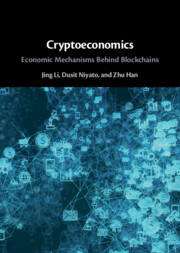Refine search
Actions for selected content:
48585 results in Computer Science
Provable observation noise robustness for neural network control systems
-
- Journal:
- Research Directions: Cyber-Physical Systems / Volume 2 / 2024
- Published online by Cambridge University Press:
- 08 January 2024, e1
-
- Article
-
- You have access
- Open access
- HTML
- Export citation

Cryptoeconomics
- Economic Mechanisms Behind Blockchains
-
- Published online:
- 06 January 2024
- Print publication:
- 16 November 2023
PhD Abstracts
- Part of
-
- Journal:
- Journal of Functional Programming / Volume 33 / 2023
- Published online by Cambridge University Press:
- 05 January 2024, e15
-
- Article
-
- You have access
- Open access
- HTML
- Export citation
Exploring the impact of design tool usage on design for additive manufacturing processes and outcomes
-
- Journal:
- Design Science / Volume 10 / 2024
- Published online by Cambridge University Press:
- 05 January 2024, e1
-
- Article
-
- You have access
- Open access
- HTML
- Export citation

Complexity Economics and Sustainable Development
- A Computational Framework for Policy Priority Inference
-
- Published online:
- 04 January 2024
- Print publication:
- 25 January 2024
-
- Book
-
- You have access
- Open access
- Export citation
Machine Learning for Smart and Energy-Efficient Buildings
- Part of
-
- Journal:
- Environmental Data Science / Volume 3 / 2024
- Published online by Cambridge University Press:
- 04 January 2024, e1
-
- Article
-
- You have access
- Open access
- HTML
- Export citation
Scrolling back: Remediation within and through digital memory work
- Part of
-
- Journal:
- Memory, Mind & Media / Volume 2 / 2023
- Published online by Cambridge University Press:
- 03 January 2024, e10
-
- Article
-
- You have access
- Open access
- HTML
- Export citation
Communicative remembering: Revisiting a basic mnemonic concept
- Part of
-
- Journal:
- Memory, Mind & Media / Volume 2 / 2023
- Published online by Cambridge University Press:
- 03 January 2024, e9
-
- Article
-
- You have access
- Open access
- HTML
- Export citation




